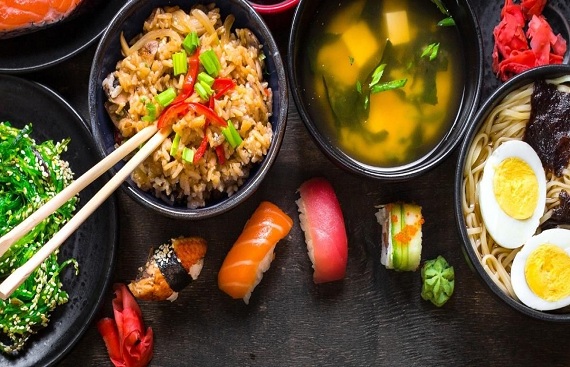From Sushi to Sake: A Japanese Cuisine and Cultural craze in India

Japanese, a custom current generations crush into from Anime to its top Cuisine which is recognized worldwide for its complexity, harmony, and beauty, which make it ‘One Piece’ among the World's most popular cuisines. Japan is already well-known for its extensive culinary legacy embedded in tradition and culture. And these cuisines have become a crucial part of global food culture and are trending in India nowadays. Japanese Cuisine has evolved to suit the Indian palate while retaining its traditional flavor and beauty. In this article, we will have a tour on cultural significance of Japanese Cuisine and its evolution in India.
The Essence of Japanese Cuisine and Why it's so Special
Japanese Cuisine also known as Washoku is a unique culinary art form. These cuisines are based on harmony, balance, and simplicity, which have evolved through centuries, fusing traditional and modern techniques. If you're wondering what makes Japanese Cuisine makes, you say 'oishii' is because it highly prioritizes on fresh and high-quality ingredients. This essence of using fresh ingredients aims to bring out the flavors and textures of the ingredients in the recipes also known as Umami. Japanese Cuisine mainly focuses on health and well-being. These meals use fresh vegetables, lean proteins, and healthy cooking methods such as grilling, steaming, and simmering.
The importance of healthy eating is what makes Japanese Cuisine popular. It is also well-known for its unique presentation. Kaiseki or the art of food presentation is vital part in Japanese Cuisine as you may be seen. Kaiseki is a multi-course meal consisting of several small, elegantly presented dishes; each intended to emphasize a different flavor, texture, or cooking method. Each dish's presentation is carefully organized, focusing on balance, harmony, and beauty. Many traditional Japanese foods are profound from cultural and historical roots, and this Cuisine has shaped Japanese identity, culture, and tradition around the world.
The cultural significance of Japanese Cuisine
![]()
Japanese Cuisine has great cultural significance and has shaped Japan’s identity and culture. Many traditional Japanese meals have historical roots that go back to ancient times, such as sushi, which began as a way of preserving fish and now it’s eaten at celebrations and events. The art of Kaiseki, or food presentation, is also deeply rooted in Japanese culture and passed down through generations of chefs—Japanese aesthetic Wabi-sabi, which means celebrate imperfection and impermanence. Furthermore, Japanese Cuisine represents Japan's dedication to health and well-being.
Exploring the Adaptations & Fusion of Japanese and Indian Flavors
Japanese food has grown popular in India, with the number of restaurants increasing nationwide in major cities. The first Japanese restaurant in India, "Wasabi by Morimoto," was opened in Mumbai in 2004; since then, Japanese Cuisine has become a city's mainstay. While many Japanese restaurants in India serve traditional Japanese dishes such as Sushi, ramen, and tempura, Some Indian adaptations and innovations in Japanese Cuisine have also emerged. Many restaurants have developed fusion dishes that combine Japanese flavors and ingredients with Indian spices and methods. Another factor for Japanese Cuisine's appeal in India is the growing interest in international Cuisine. As Indian customers travel more and get exposed to diverse cultures, they are curious about new and exotic foods. With its unique flavors and presentation is why Japanese Cuisine has become popular.
The Influence of Japanese Cuisine on Indian Food Culture
Japanese Cuisine has already gained popularity in India during the last few years. As seen by the increasing number of Japanese restaurants, chefs, and culinary festivals around the country. The future of Japanese Cuisine in India looks promising as more Indians become exploratory eaters searching for fresh and unusual food experiences. With the introduction of new flavors, ingredients, and cooking techniques, Japanese food has profoundly impacted Indian culture. Sushi with mango and avocado, as well as Japanese-style curry with Indian spices have already become popular at many Japanese restaurants in India. Japanese food has also influenced a new generation of Indian cooks who blend Japanese ingredients into their cooking styles. Furthermore, the popularity of Japanese Cuisine has increased knowledge and admiration of Japanese culture in India. Overall, the future of Japanese food in India appears to have a long-term positive impact on Indian culture.
A Look at Popular Japanese Dishes Trends in India
![]()
Let's see what's on the Menu; the Japanese dishes trending across the country are Sushi, a traditional Japanese dish of rice, seafood, or vegetables, famous among food lovers. Maki rolls, nigiri, and sashimi are some of the popular varieties of Sushi. Ramen some people are familiar with this dish, the famous ichiraku from Naruto; it's a hearty noodle soup famous around. Yakitori, grilled chicken skewers, and tempura, a dish of battered and deep-fried seafood or vegetables. Additionally, Japanese desserts like matcha ice cream and mochi, a sweet rice cake, are some of the Food Trends in India.
In conclusion, Japanese cuisine has established itself as a unique and valued culinary tradition all over the world, and India is no exception. It is fascinating to think of the creation of fresh, cutting-edge meals that combine Indian and Japanese culinary traditions as Japanese cuisine continues to change and adapt to the local flavours. So, if you haven't already tried Japanese cuisine, go ahead and say "itadakimasu" before you start your meal and "Sayonara" as you bid farewell to your dining experience.

